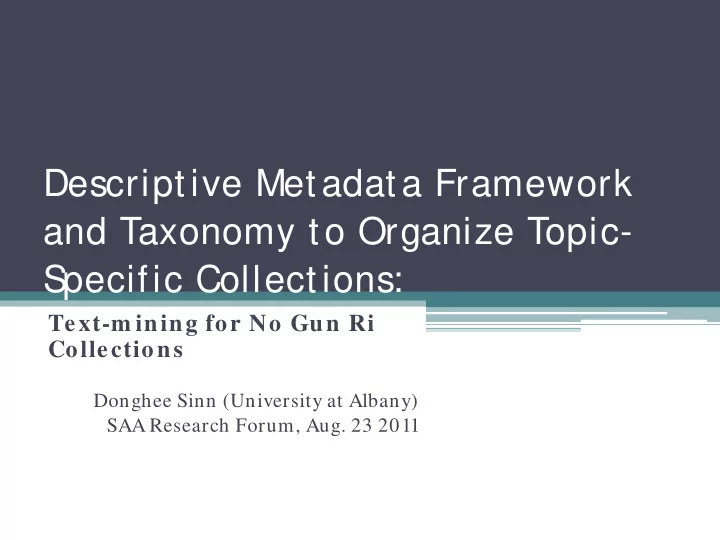

Descriptive Metadata Framework and Taxonomy to Organize Topic- S pecific Collections: Text-m ining for No Gun Ri Collections Donghee Sinn (University at Albany) SAA Research Forum, Aug. 23 2011
Topic-S pecific Collections • Various types of resources that are pertinent to a topic • A typical descriptive metadata standard (MARC, Dublin Core) may not be useful. • Topical approach to collect information ▫ Library pathfinders ▫ Digital libraries ▫ Individual web sites
No Gun Ri • No Gun Ri Massacre during the Korea War (July 1950) ▫ Mass killing of South Korean refugees under a railroad overpass at No Gun Ri ▫ By 7 th Regiment soldiers in 1 st Cavalry Division ▫ Harsh refugee policies appeared in military documents from neighbor army units (25 th Infantry, etc) ▫ First reported in the US by AP in 1999 ▫ Controversies over testimonies of veterans (Edward Daily) and US No Gun Ri Review
NGR Collection • Materials from survivors’ community, archival documents, journalistic publications, academic research studies, legal documents, government reports, media broadcasting, etc. • A variety of types in format and nature ▫ Hard to organize effectively, using an existing descriptive standard
Text-Mining • Finding representative patterns from unstructured textual data • Analyzing the contents in the collection to find how the contents represent the collection itself • Text analysis tool: TAPoR (Text Analysis Portal for Research) ▫ Keywords Finder top 20 words; top 10 word pairs; and top 10 word triplets recommended keywords/ phrases
Text-Analysis for NGR Collection (Preliminary) • 31 Archival Materials ▫ 27 military documents ▫ 4 survivors and the AP reporters documents • 23 Academic publications ▫ in fields of history, law, media studies, Asian studies, military, etc. Journal articles, thesis and dissertations, chapters of books • 55 Journalistic publications ▫ news and magazine articles in US, UK, and Korea • 1 government report • 1 web package
Text-Analysis for NGR Collection • All text, including captions, citations, footnotes • Excludes images, audio, and multimedia • Only English materials analyzed ▫ TAPoR Keywords Finder does not support other languages
Problem • “No” in No Gun Ri ▫ Stopword, not counted: “Gun,” “Ri,” “Gun Ri” appeared as keywords ▫ The chances that the term “No Gun Ri” is used for searching is assumed to be low.
Findings: Text Frequency • Taxonomy Creation ▫ Top 20 keywords ▫ Top 10 word pairs ▫ Top 10 word triplets • Descriptive Data Categories ▫ Recommended Keywords and Phrases 175 terms: 143 words after eliminating repetitive terms (refugee and refugees) and meaningless words (pg, mr).
Top 20 keywords Top 10 word pairs Top 10 word triplets 1 st Cavalry Division Korean Gun Ri Ri Korean war Gun Ri Massacre Gun South Korea Gun Ri incident 7 th Cavalry regiment War South Korean Korea North Korean Gun Ri researchers South Review team Gun Ri research 1950 Jul-50 Double railroad overpass 1 st Cavalry Refugees Gun Ri Review 7 th Cavalry Army World war II 25 th Infantry division Soldiers Cavalry division Military American Civilians July Team North Cavalry Archival States Review
Keywords by Type: Top 10 Word Pairs Archival Academ ic Journalistic Governm ent Web Gun Ri Gun Ri Gun Ri Gun Ri Gun Ri 7 th Cavalry Korean War South Korean Review Team South Korean 1 st Cavalry Railroad overpass South Korea Korean War Jul-50 1 st Cavalry Double railroad North Korean North Korean South Korea Cavalry regiment South Korean South Korea Cavalry Division Cavalry Division 2 nd battalion 7 th Cavalry Archival materials American soldiers Korean War South Korean North Korea Korean civilians Air Force North Korean 7 th Cavalry 2 nd Battalion Korean Report Archival documents Air Force Anti-Americanism North Korean Jul-50 Aug-50 Ex GIs Jul-50 Cav 590 Air Force Eighth Army Korean Refugees Red: specific terms Blue: generic terms
No Gun Ri Taxonomy (from all word combinat ions) NGR Research/ Politics/ General NGR History Background controversy Diplomatic • War • 1950 • Review • Anti-Americanism • Army • South Korea • Research • International Humanitarian law • Soldiers • Refugees • Report • Customary • Military • Civilians • Law International Law • 1 st Cavalry Division • Cavalry • Researchers • South Korean • 7 th Regiment • Division • AP Government • Koreans • Railroad • Daily • Korean War • Railroad bridge • Entry • World War II • Railroad overpass • Veterans • Air Force • Double railroad • Author overpass • American Soldiers • Comment • Order • Eighth Army • Archival Materials • 25 th Infantry • Review Team Division • Korean Report • North Korean • No Gun Ri Review soldiers • Korean Witness • Im Gae Ri Statements • Joo Gok Ri • Periodic • Fighter Bomber Intelligence Report Squadron
Data Categories (identified from recommended keywords/ phrases) • People ▫ Organization (1 st Cavalry Division); group of persons (veteran, refugees); occupation; nationality (South Korean, American) • Place ▫ Geographic name; landmark (railroad bridge) • Time (1950, World War II) • Activities ▫ Functions (evidence); process and technique (research, analysis, operations) • Topic (law, anti-Americanism) • Genre ▫ Resource type (documents, war diary, articles, reports, imagery); media/ format (film); nature (journalistic) • Object (railroad, tunnel) • Event (Korean War, Massacre) • Proper names ▫ Personal names(Daily), geographical names (Joo Gok Ri), event names, titles (NY times), Organization names (AP, Eighth Army)
Discussions • Simple keyword extraction can be a useful tool ▫ Inexpensive method for hard data ▫ Relatively effective for creating taxonomy and analyzing properties of contents for data categories • Different results for different types of texts ▫ Archival documents vs. academic publications: specific vs. generic keywords • Amount of text matters ▫ The keyword extraction based on frequency ▫ The amount of text in archival documents vs. that of academic publications • Text Analysis can be done by type, then results be aggregated
Thank you. Donghee Sinn (dsinn@albany.edu)
Recommend
More recommend